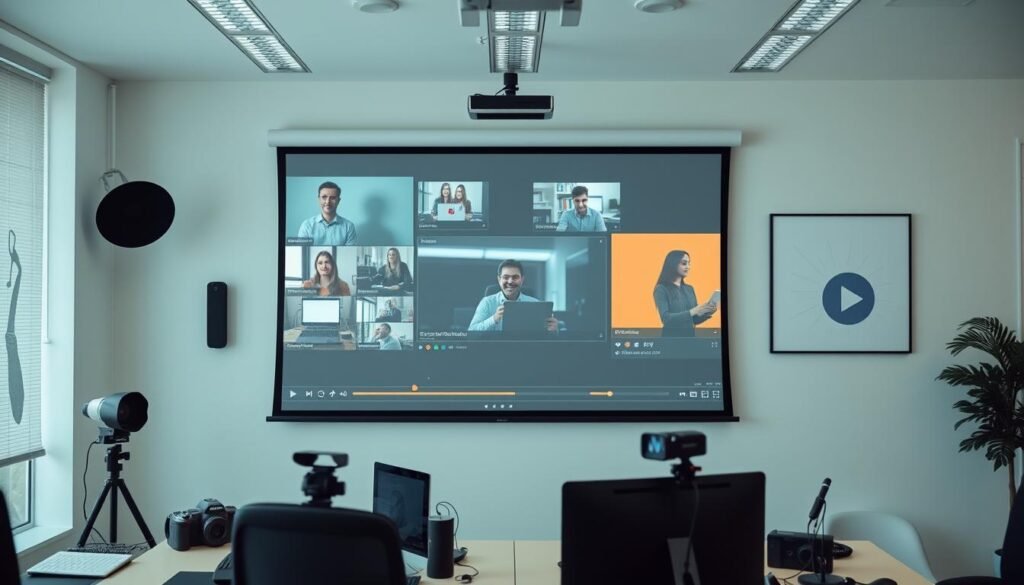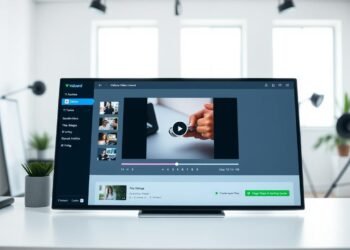In today’s world, ads are very important. Businesses want to grab people’s attention and get them to act. The key is in the ad’s look and message.
Studies show ads are very important for success. For example, GumGum’s ads were six times better than usual. Also, new ad features can make people click more, up to 9.9% more.
With so many ads out there, making yours stand out is key. You can use cool features like product carousels and games. This guide will show you how to make ads that really work.
Key Takeaways
- High-converting ad creatives are essential for capturing audience attention and driving action.
- Advanced creative features can increase click-through rates by up to 9.9%.
- Product carousels and gamified elements improve user engagement and interaction.
- Users encounter 4,000 to 10,000 ads daily, necessitating standout ad content.
- Effective ad creatives incorporate visual design, ad copy, compelling CTAs, and branding.
Understanding the Basics of Ad Creatives
In today’s world, knowing about ad creatives is key for good marketing. To make ads that work well, it’s good to know what they are and why they matter.
What Are Ad Creatives?
Ad creatives are the pictures and words in ads that catch your eye and make you want to act. They include:
- Product Carousels: These show many images of products or features.
- Brand-Narrative Videos: Videos that tell a story to keep you interested.
- Gamified Elements: Fun parts that make ads more exciting.
Importance of Ad Creatives in Marketing
Good ad creatives are very important. They can make a big difference in how well a campaign does. Google says that good ad creatives can make a campaign up to 70% more effective. Here are some important points:
| Statistic | Insight |
|---|---|
| Facebook’s 20% Rule | Images with 20% or less text do better. |
| 91.7% Attention Increase | Ads with a person’s face get more attention. |
| 11 Ads Clicked | People click on about 11 ads a month on Facebook. |
When making ad creatives, adding social proof and credibility helps a lot. It’s also important to clearly say what the offer is, how it helps, and what to do next.
Using dynamic ads and targeting by life events can show the right products to the right people. This can help ads work better. Companies like Facebook show how big and important this is for success.
Identifying Your Target Audience
Creating good ad strategies starts with knowing who you’re talking to. You might be aiming at young people or a special group. It’s key to know what they like and need.
Demographics and Psychographics
Knowing your audience’s age, gender, and where they live helps a lot. But it’s also important to know their interests and values. For example, a beauty brand talking about “acne” in ads will hit home with their audience.
Using customer reviews and endorsements can also help. It makes people more likely to buy what you’re selling.
Researching Your Audience’s Needs
Doing research is vital to make ads that really speak to your audience. Look at what they like, what they don’t like, and what they’re worried about. Ads that talk about these things right away grab attention fast.
Adding a sense of urgency, like a limited-time offer, can also help. It makes people act quicker.
Our brains process images really fast, in under 13 milliseconds. So, using pictures and keeping ads consistent is key. More than half of us learn better through pictures. This makes good visual storytelling very important for ads.
Crafting a Compelling Message
Creating a great message is key in ad creative best practices. Knowing what your audience feels and using that in your ads can make your campaign stand out. This way, you can get a quick response and make your brand more relatable to people.
The Role of Emotion in Advertising
Emotions play a huge role in ads. Ads that touch our feelings can make us remember brands more. Studies show that ads can make us remember brands up to 80% more.
Good ad practices use feelings to make messages stick in our minds.
Key Elements of a Strong Call to Action
A good call to action (CTA) turns interest into action. Using different colors for CTAs can increase clicks by over 30%. Words like “Shop Now” or “Get Started” that pop out can get more people involved.
Try different CTA words to see what works best for you.
Writing Engaging Headlines
Great headlines are vital for ads. They should be short, clear, and about 25 characters long. This way, they won’t get cut off in ads.
Headlines that speak to certain groups of people work better. Quick, catchy headlines grab attention fast. People decide to click on ads in just 1-3 seconds.
| Headline Length | Engagement Potential |
|---|---|
| Around 25 characters | High |
| Beyond 25 characters | Moderate |
By focusing on emotions, strong CTAs, and catchy headlines, your ads will likely get better. This makes your campaigns more effective and memorable.
Designing Eye-Catching Visuals
The look of your ads is very important. It can make your ads more interesting and appealing. Let’s look at what makes them stand out.

Choosing the Right Color Scheme
Colors can grab attention and send messages. Ads with good colors help people remember brands better. Facebook says to use certain sizes for ads to get more views.
Choose colors that are easy to see and read. This makes your ads pop online.
The Impact of Image Quality
Good images are key for ads. Studies show images affect buying decisions more than text. MiWay’s ad quality boost led to more sales.
Make sure images are the right size and clear. This keeps your visuals sharp and effective.
Using Typography Effectively
Fonts are important for ads too. Sans-serif fonts are best for screens. Adding a clear call-to-action (CTA) in your ad can boost engagement.
Match your ad design with your landing page. This helps keep people on your site longer and improves your return on investment. Strategyzer made $8,000 from ads costing just $500, showing great profit.
By paying attention to these visual details, you can make your ads better. This will help your marketing a lot.
A/B Testing Your Ad Creatives
Testing your ad creatives with A/B testing is key to better conversion rates and user interest. It lets marketers try out different ad parts to see what works best. The goal is to make ads better and safer.
What is A/B Testing?
A/B testing, or split testing, compares two ad versions to see which one does better. It’s important for making ads better, as it shows which changes help more. For example, testing different calls to action can really change how many people click.
Analyzing Test Results
After A/B testing, it’s important to look at the results carefully. By checking things like click-through rates and conversion rates, you can see which ad works better. Having a clear goal, like a 25% increase in clicks, makes the results more useful.
Iterating Based on Feedback
After getting feedback and data, you can make small changes to your ads. It’s important to change one thing at a time to know what works. Also, be patient, as A/B testing can take about 90 days to get good results.
Utilizing Video Content
Video content is key for ads, boosting engagement and sales. It can share complex ideas in a fun way. Here, we’ll see why video is great for ads and share tips for making engaging videos.
Why Video is Essential for Ads
Videos grab viewers and share messages better than text. Here’s why:
- Increased Retention: People remember 95% of a video message, but only 10% of text.
- Higher Conversion Rates: Video ads can increase sales by up to 80%.
- Enhanced Purchase Likelihood: 64% of people are more likely to buy after watching a product video.
- Improved Click-Through Rates: Adding a video to an email can raise click rates by 200-300%.
- Boost in Brand Awareness: Video ads can make your brand 70% more known to your audience.

Tips for Creating Engaging Video Content
Creating good video content needs focus on key areas. Here are some important ad creative tips:
- Capture Attention Quickly: Grab viewers in the first 3 seconds. A good start can make viewers watch 15% more.
- Highlight Key Messages: Share your main idea clearly to avoid confusion.
- Mobile Optimization: Make sure your video works well on phones, as most online views come from mobiles.
- Emotional Storytelling: Use stories that touch viewers’ hearts. Emotional videos can win 31% more viewers than non-emotional ones.
- Call to Action: Videos with a call to action can get up to 380% more sales than those without.
- Brand Consistency: Keep your brand’s look and feel the same to build trust.
- Social Proof: Use things like testimonials to make your ad more believable. For example, the Love Leggings ad shows how comfy and good value they are.
- A/B Testing: Try different video starts and parts to see what works best. This can increase views by up to 40%.
Let’s look at some stats to show how these ad creative tips work:
| Metric | Statistic |
|---|---|
| Retention Rate | 95% for video content |
| Conversion Rate Boost | Up to 80% |
| Email CTR Increase | 200-300% |
| Brand Awareness Increase | 70% |
| Engagement Boost from Emotional Storytelling | 31% |
| Conversions with CTA | Up to 380% |
Using these ad creative tips will make your videos more engaging. They will also help your business grow a lot.
Optimizing for Different Platforms
Each platform needs its own ad strategy to get the best results. Facebook and Instagram love pictures and videos. Google Ads focus on text and calls to action. LinkedIn wants ads that feel professional.
Facebook vs. Instagram Ads
Facebook and Instagram have lots of users. They like ads with great images and videos. Carousel ads show many pictures or videos at once.
Retargeting ads help by showing ads to people who’ve seen your brand before. Ads with customer testimonials can make people trust you more.
Ads with big discounts can make people buy more. Instant Experience ads load fast. Using high-converting ad examples can make your ads better.
Adjusting for Google Ads
Google Ads are all about text. Your ad should be clear and have a strong call to action. It’s important to write ads that match what people are searching for.
Making ads personal can really help. Ametller’s ads did great by focusing on specific groups of people.
Considerations for LinkedIn Advertising
LinkedIn ads need to be professional. They should talk to business people and solve their problems. Making ads personal can really boost how well they do.
Roma’s ads did a lot better by using smart, automated ads. Always check how your ads are doing and change them based on what you learn.
Platform Comparison
| Platform | Key Strategies | Benefits |
|---|---|---|
|
| |
| Google Ads |
|
|
|
|
Leveraging User-Generated Content
Using User-Generated Content (UGC) in ads makes them feel real and relatable. This helps brands connect better with people. It makes ads more like advice from friends.
Benefits of UGC in Advertising
UGC has many good points for ads:
- UGC ads get 73% higher engagement than regular ads.
- 92% of people trust UGC ads more than usual ads.
- User-generated videos get 10 times more views than videos made by brands.
- Brands saw an 85% increase in social media sales with UGC.
- UGC cut 40% of customer costs to get new customers.
UGC helps brands connect with people better. This leads to more loyalty and interest.
How to Encourage Customer Participation
To get people to make and share content, try these:
- Incentivize participation: Offer discounts, giveaways, or contests to get people involved.
- Launch engaging campaigns: Make campaigns that make people want to create content.
- Facilitate easy sharing: Use places like TikTok, Instagram Reels, and Facebook for easy sharing.
To get the most out of UGC, remember these tips and goals:
| Platform | Optimal Length | Key Strategy |
|---|---|---|
| TikTok | 7-15 seconds | Fast-paced opening of 0.5-1.5 seconds |
| Instagram Reels | 15-30 seconds | Strong thumbnail optimization |
| Facebook Feed | 15-60 seconds | Square format (1:1) |
By using these tips, brands can really benefit from UGC. This makes ads work better.
Measuring Success and Analytics
Knowing how well your ads do is key to better marketing and more money. Important numbers like Click-Through Rate (CTR), Conversion Rate, Cost Per Acquisition (CPA), and Return on Ad Spend (ROAS) show how good your ads are. They tell you if your ads are working well and if they’re worth the money.
Key Metrics for Ad Performance
CTR shows how many people click on your ad. A high CTR means your ad grabs people’s attention. The Conversion Rate shows how many people do what you want after clicking. Good calls-to-action can help a lot.
Cost Per Acquisition (CPA) tells you how much it costs to get a new customer. A high Return on Ad Spend (ROAS) means your ads are making a lot of money. It’s a key number to watch.
Tools for Tracking and Analyzing Results
Many tools help you see how your ads are doing. Google Analytics gives deep insights and easy-to-see charts. Tools like Hotjar show how people interact with your ads, helping you make them better.
Facebook Ads Manager lets you make changes automatically. It also helps you test different ads to see which one works best. This way, you can make your ads even better.
Using the right tools and strategies helps marketers make smart choices. This leads to better ads and more success in the future.












